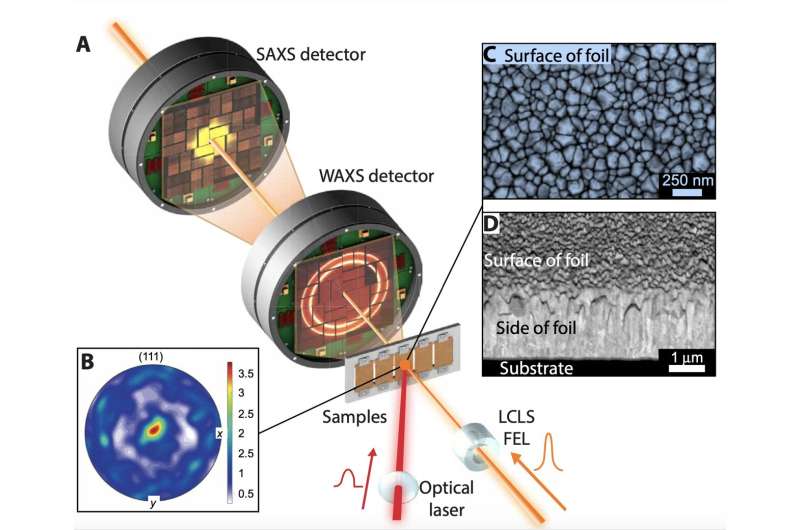Researchers capture how materials break apart following an extreme shock

Understanding how materials deform and catastrophically fail when impacted by a powerful shock is crucial in a wide range of fields, including astrophysics, materials science and aerospace engineering. But until recently, the role of voids, or tiny pores, in such a rapid process could not be determined, requiring measurements to be taken at millionths of a billionth of a second.
Now an international research team has used ultrabright X-rays to make the first observations of how these voids evolve and contribute to damage in copper following impact by an extreme shock. The team, including scientists from the University of Miami, the Department of Energy's SLAC National Accelerator Laboratory and Argonne National Laboratory, Imperial College London and the universities of Oxford and York published their results in Science Advances.
"Whether these materials are in a satellite hit by a micrometeorite, a spacecraft entering the atmosphere at hypersonic speed or a jet engine exploding, they have to fully absorb all that energy without catastrophically failing," says lead author James Coakley, an assistant professor of mechanical and aerospace engineering at the University of Miami. "We're trying to understand what happens in a material during this type of extremely rapid failure. This experiment is the first round of attempting to do that, by looking at how the material compresses and expands during deformation before it eventually breaks apart."
Swiss cheese
In the experiment, the researchers shocked a copper sample with laser pulses, then scattered X-rays from SLAC's Linac Coherent Light Source (LCLS) X-ray free-electron laser through the material to track its deformation. From the patterns the scattered X-rays made in two detectors, they were able to see how the shock compressed and then expanded the material's atomic lattice in one detector while simultaneously observing void evolution in the second detector.
The initial squeeze closed preexisting voids in the material, Coakley says. As the material expanded again, "You get more and more of these little voids nucleating and growing as the damage spreads through the material, like a slice of swiss cheese. At a certain point, they begin to join together until eventually you're left with large pores that cause ultimate failure."
The researchers also discovered that the material's strength, or ability to resist damage, depended on how fast the external stress was applied and released.
"The brightness of the X-rays and the time scales we were able to look at were crucial to the success of this experiment," says SLAC Director of Strategic Planning Despina Milathianaki, who conceived and oversaw the LCLS experiment. "This combination of factors allowed us to track exactly what happened within the sample as it broke apart at time and length scales that previously could only be simulated, offering insight into the underlying defects that caused material failure."
Surviving the shock
This experiment focused on demonstrating how the technique can be used to understand ultrafast material deformation. The researchers plan to do future experiments on more advanced materials and under experimental conditions that more closely match real-world applications.
"It was exciting to be able to visualize and understand the full life cycle of a material," Milathianaki says. "It's a great demonstration of what can be done at LCLS to understand material failure more broadly. The end goal is to fully understand how materials fail so you can design new materials that can better withstand these intense conditions."
More information: James Coakley et al. Femtosecond quantification of void evolution during rapid material failure, Science Advances (2020). DOI: 10.1126/sciadv.abb4434
Journal information: Science Advances
Provided by SLAC National Accelerator Laboratory





















